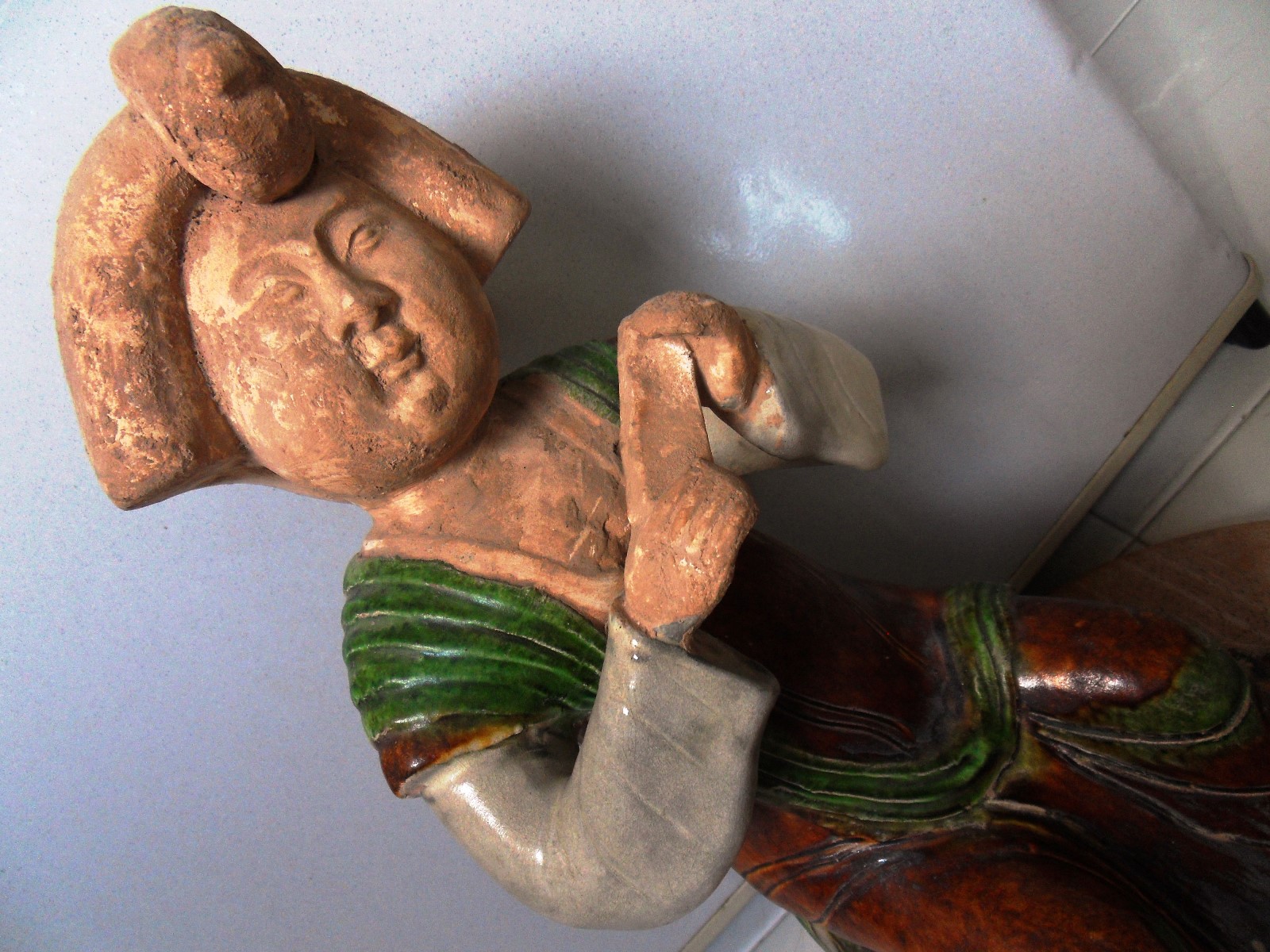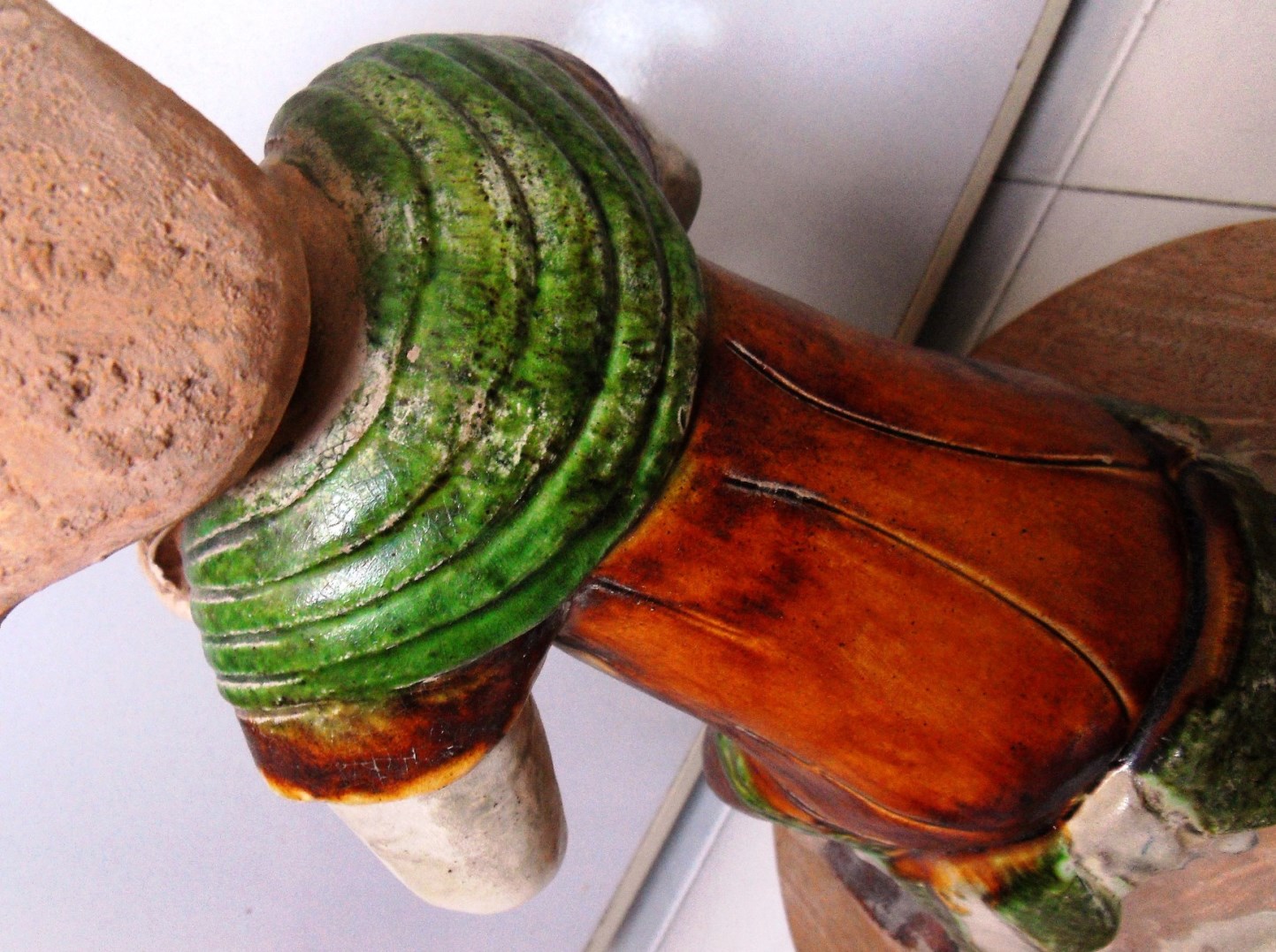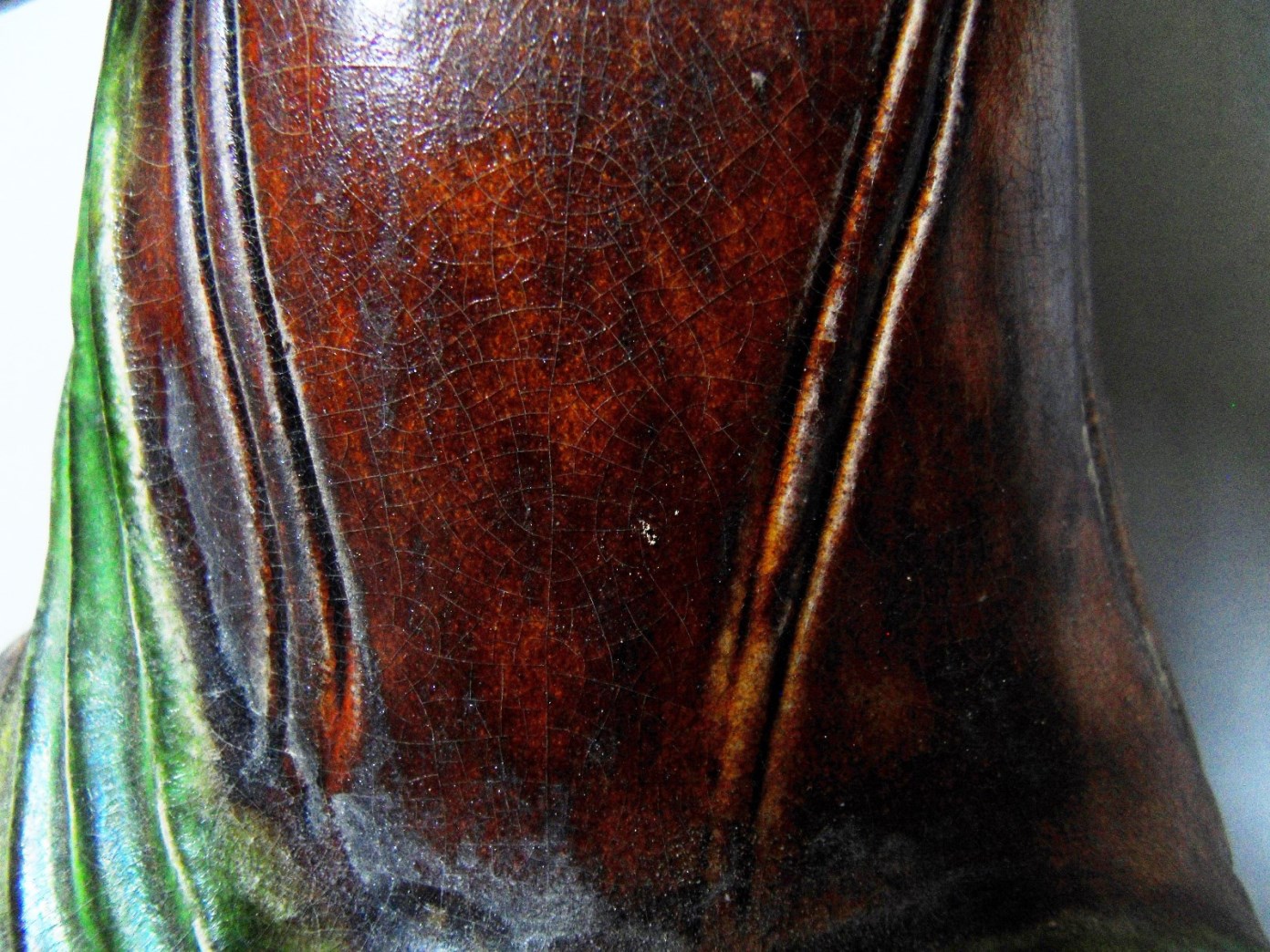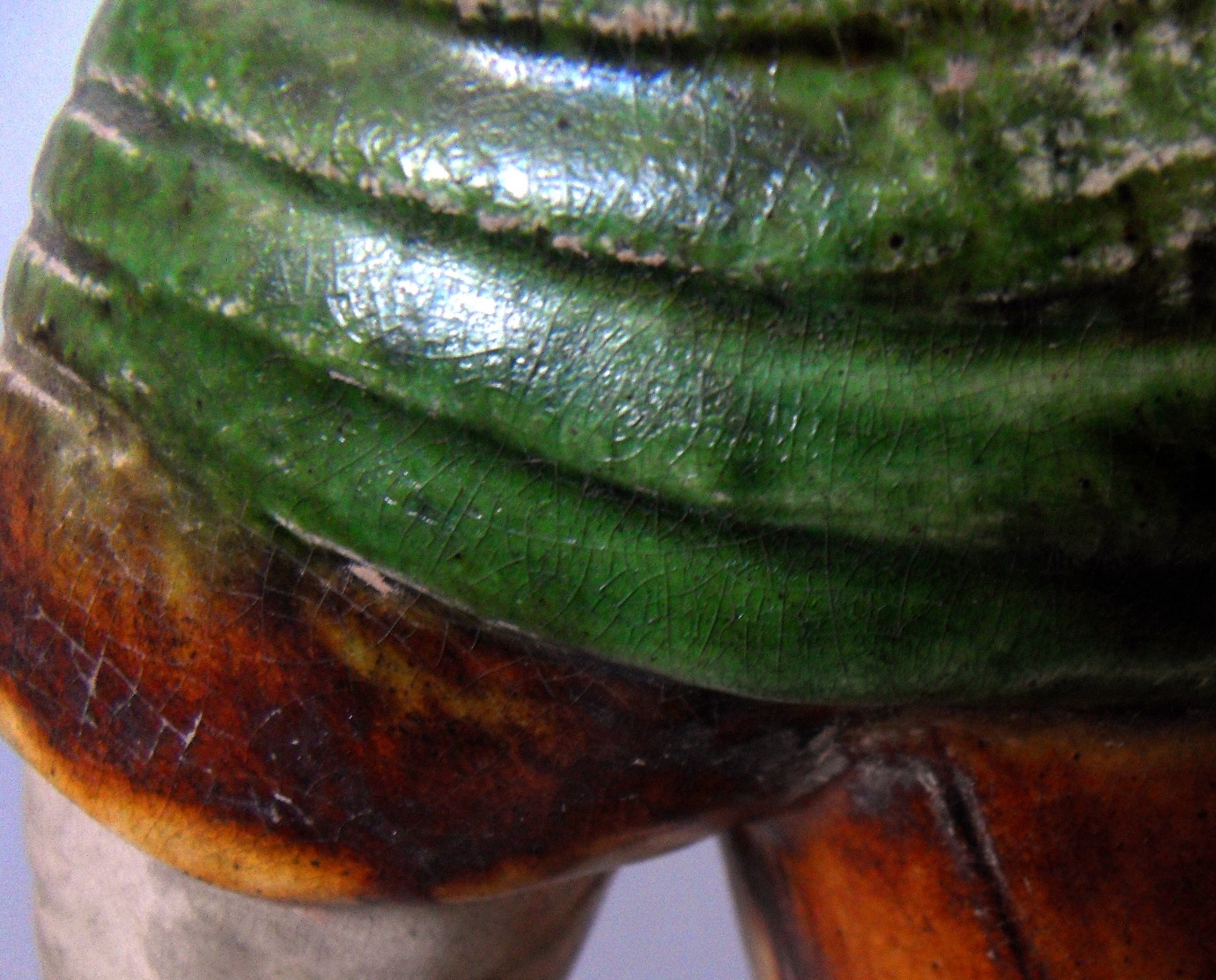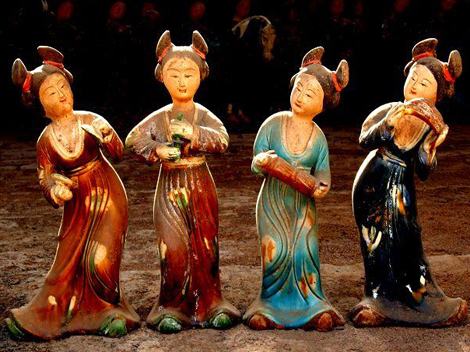
|
Subject:Clear, Transparent Glaze Over White Clay, Not White/Grey Glaze
Posted By: jac Mon, Apr 06, 2015
The figurine has no white or grey glaze. The sleeves are covered with clear, transparent glaze which looked a little greyish, perhaps due to degradation over time.
In the absence of a TL test, there is another feature present on this figurine which rule out the possibility that it is recent. It is the way the soil is attached to the hollow portion of the figurine. Impossible to imitate.
Below is an article on Chinese Tri-colored Pottery of the Tang Dynasty, taken from http://arts.cultural-china.com/en/31Arts7938.html.
Sancai, or tri-colored pottery, was the magnificent flagship ceramic ware of the Tang Dynasty, as it held not only a unique style but a special function. During an archeologiical dig at the beginning of the 20th century, people uncovered, near an ancient tomb at Luoyang in Henan Province, large quantities. Tang-styled, tri-colored pottery made in the Ming Dynasty. Its one of a kind artistic expression was known to the world once again.
The tri-colored pottery was based on and as an improvement of the lead-glaze pottery of the Han Dynasty. it had bodies made of white pottery clay and covered in low-temperature glaze which contained lead. The glaze itself was mixed with iron, copper, manganese, cobalt and other metals as coloring, and then fired at temperatures between 750 to 800 degrees Celsius. The so called “tri-color” really pertains to multiple colors, including green, yellow, burnt ochre, red, white, blue, black and more.
Some colors were applied singularly while others were applied as mixtures. Before applying glaze, a layer of dressing clay was used, followed by layer after layer of colored glaze in order to realize the intended effect. Some tri-colored pottery adopted traditional decorative styles such as impression, appliqué, engravings, embossed sculpture and so on. The tri-colored pottery ingeniously conveyed lavish effects and sometimes vivid stories. Some Tang-style tri-colored (Tang Sancai) potteries sported gold outlines, which appeared particularly extravagant. Among the excavated works from tombs of Tang Dynasty imperial members, this golden outline effect was especially striking.
The Beijing Palace Museum and Shaanxi Museum, respectively house the tri-colored camel figuring and sculpture of man playing instrument on camel back, which are both priceless collection pieces, modeled in the realistic style. the camel figurines are about 1 meter tall, depicted in either a marching pose or upright standing posture, appearing sumptuous and in grand spirit. The firing and modeling are excellent on both pieces. These double-humped camels, the models for which the sculptures were based, often traversed the Silk Road in the Tang Dynasty and were of a Central Asia origin. More than just a mode of transportation, with their “exotic” appearances, these camels were loved by all people in China during its time. It serves as an indication as to how active and frequent commercial activities and artistic performances were back in the old days. Tri-colored pottery from the Tang Dynasty was a tremendous breakthrough from the monotony, crudeness and rigid styling of the single-colored, glazed pottery. With its realistic and romantic presentation (e.g. figures, animals, tomb beasts), Tang Sancai tells of the prosperous times when nationalities and cultures converged and foreign exchanges were frequent.
Findings of buried Tang-style tri-colored pottery were mostly concentrated around Xi’an and Luoyang, both northern Chinese cities. From excavations of kiln site, the Gong County in Henan, Xing Kilns in Hebei and Yaozhou kilns of Shaanxi were the centers of production. In the south, areas such as Changsha and Wuhan had Tang mausoleums that unveiled works of tri-colored pottery. What’s special was that these potteries had very well preserved glazes, smooth and glistening. It also had very strong and interesting local styling, and indications that they may very well have been produced at kilns nearby. Aside from the type of tri-colored pottery that were used as burial objects, there were also many vessels made for daily use, such as jars, kettles, lamps, dishes, bowls and so forth.
Tri-colored pottery was immensely popular during the height of the Tang Dynasty. it was sold domestically as well as exported to far away countries. After the late-Tang period, tri-colored pottery production dwindled; the works produced were also not as exquisite and high quality as those of the prime Tang period. By the Five Dynasties Period, tri-colored pottery was no longer produced. However, its impact on colored pottery and porcelain of later periods were immense. Even though its glory was short lived, Tang Sancai is still a most favored artifact for people today.
Source: Chinese Ceramics, published by China International Press
URL Title :Chinese Tri-colored Pottery


|
 Brown & Green Glazed, White Clay Seated "Tang" Lady For Identification
Brown & Green Glazed, White Clay Seated "Tang" Lady For Identification  ( China & Japan ) - jac - Apr 01, 2015 (10:51 PM)
( China & Japan ) - jac - Apr 01, 2015 (10:51 PM)  Re: Brown & Green Glazed, White Clay Seated "Tang" Lady For Identification - pierrevdw - Apr 02, 2015 (07:16 AM)
Re: Brown & Green Glazed, White Clay Seated "Tang" Lady For Identification - pierrevdw - Apr 02, 2015 (07:16 AM)  Re: Brown & Green Glazed, White Clay Seated "Tang" Lady For Identification - jac - Apr 03, 2015 (07:54 AM)
Re: Brown & Green Glazed, White Clay Seated "Tang" Lady For Identification - jac - Apr 03, 2015 (07:54 AM)  Re: Brown & Green Glazed, White Clay Seated "Tang" Lady For Identification - pierrevdw - Apr 06, 2015 (12:08 AM)
Re: Brown & Green Glazed, White Clay Seated "Tang" Lady For Identification - pierrevdw - Apr 06, 2015 (12:08 AM)  Clear, Transparent Glaze Over White Clay, Not White/Grey Glaze - jac - Apr 06, 2015 (07:44 AM)
Clear, Transparent Glaze Over White Clay, Not White/Grey Glaze - jac - Apr 06, 2015 (07:44 AM)  Fine Meshed Crackle On Genuine Tang Sancai?
Fine Meshed Crackle On Genuine Tang Sancai?  - jac - Apr 08, 2015 (01:10 AM)
- jac - Apr 08, 2015 (01:10 AM)  Re: Fine Meshed Crackle On Genuine Tang Sancai? - pierrevdw - Apr 10, 2015 (04:54 AM)
Re: Fine Meshed Crackle On Genuine Tang Sancai? - pierrevdw - Apr 10, 2015 (04:54 AM)  Re: Fine Meshed Crackle On Genuine Tang Sancai? - jac - Apr 12, 2015 (03:28 AM)
Re: Fine Meshed Crackle On Genuine Tang Sancai? - jac - Apr 12, 2015 (03:28 AM)  Re: Fine Meshed Crackle On Genuine Tang Sancai?
Re: Fine Meshed Crackle On Genuine Tang Sancai?  - Corey - Apr 29, 2015 (11:25 AM)
- Corey - Apr 29, 2015 (11:25 AM)  Re: Fine Meshed Crackle On Genuine Tang Sancai? - jac - Apr 30, 2015 (12:42 PM)
Re: Fine Meshed Crackle On Genuine Tang Sancai? - jac - Apr 30, 2015 (12:42 PM)  Re: Fine Meshed Crackle On Genuine Tang Sancai? - Jacqueline - May 06, 2016 (10:25 PM)
Re: Fine Meshed Crackle On Genuine Tang Sancai? - Jacqueline - May 06, 2016 (10:25 PM) 